June 2003

This dragonfly looked shimmering gold and velvet black from a distance. The
only picture that captured the shimmering gold wing iridescence was also out of focus, so here you
see that the outer wing-half is actually clear. The yellow stripes on the body also glittered and
shimmered in the sun. It doesn't exactly match any of the dragonflies in my dragonfly field guide,
but is close to one of them. |
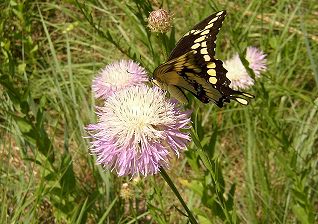 |
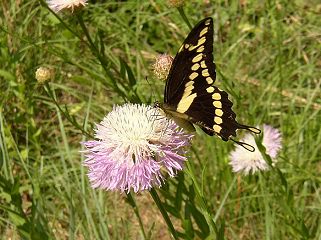 |
|
Giant swallowtails on basketflowers. The basketflowers down in the entrance meadow
only bloom for a week or less, and the giant swallowtails fairly swarm over them. These butterflies
are not only big, but active--they don't hold their wings still even while sipping nectar, but
constantly flutter. They're very alert, flying away when they see you move. So the trick was to get
in among the flowers and stand still. The undersides of their wings are mostly yellow but I could
not get in a position to photograph them except for this edge-on view of one. |
|
|
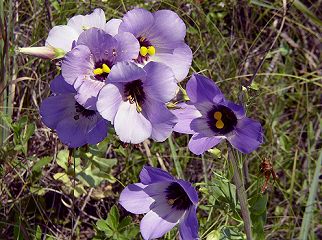 Eustoma grandiflorum, commonly called
"Texas bluebells", is not related to old-world bluebells...it's a gentian. The color of the bells
ranges from royal purple to near-white, changing as the flowers are fertilized, so that in groups
you usually see darker and lighter shades of blue-purple. In a wet year, it will form masses and
streamers of purple in every swale and ditch; in dry years it shows up sporadically wherever a
little extra water can be found. We have four of the five gentians native to this area, but only a
very small amount of another damp-ground lover, Sabatia campestris, or meadow pink. Eustoma grandiflorum, commonly called
"Texas bluebells", is not related to old-world bluebells...it's a gentian. The color of the bells
ranges from royal purple to near-white, changing as the flowers are fertilized, so that in groups
you usually see darker and lighter shades of blue-purple. In a wet year, it will form masses and
streamers of purple in every swale and ditch; in dry years it shows up sporadically wherever a
little extra water can be found. We have four of the five gentians native to this area, but only a
very small amount of another damp-ground lover, Sabatia campestris, or meadow pink.
|
|
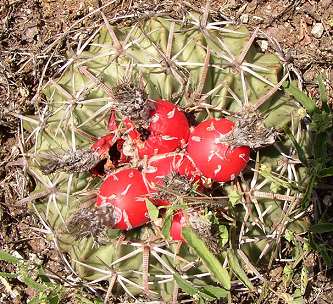
The cactus flowers page has
pictures of this cactus, Horse-crippler, in bloom. It is a low mound of very stout thorns,
definitely harmful to horses that might step on it. But as you can see, some little creature has
already raided the fruits for dinner.
|
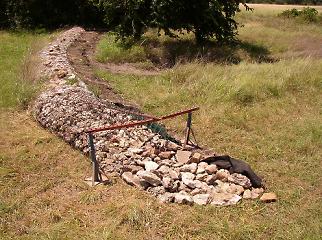
We're re-working the #3 gabion in two ways: digging out the natural swale
behind it to make it deeper (hence the dirt piled behind the gabion) and lengthening it to capture
additional runoff (near end.) What we hope is that this will result in retaining more water longer
behind the gabion. What the prairie crayfish hope is that they can dig all the tunnels they want to
let the water in their burrows. Either way, it serves wildlife...of a type. The gabion itself is
made of collected rocks (most of the ones at the near end from the horse lots) stuffed into a
"sausage" of chain link fence fabric, which it held together with hog rings. This is labor
intensive, but relatively inexpensive, since Richard gets the scrap ends of chain-link for a lot
less than the usual price per foot. |

Back to Archive
 
|



![]()


 Eustoma grandiflorum, commonly called
"Texas bluebells", is not related to old-world bluebells...it's a gentian. The color of the bells
ranges from royal purple to near-white, changing as the flowers are fertilized, so that in groups
you usually see darker and lighter shades of blue-purple. In a wet year, it will form masses and
streamers of purple in every swale and ditch; in dry years it shows up sporadically wherever a
little extra water can be found. We have four of the five gentians native to this area, but only a
very small amount of another damp-ground lover, Sabatia campestris, or meadow pink.
Eustoma grandiflorum, commonly called
"Texas bluebells", is not related to old-world bluebells...it's a gentian. The color of the bells
ranges from royal purple to near-white, changing as the flowers are fertilized, so that in groups
you usually see darker and lighter shades of blue-purple. In a wet year, it will form masses and
streamers of purple in every swale and ditch; in dry years it shows up sporadically wherever a
little extra water can be found. We have four of the five gentians native to this area, but only a
very small amount of another damp-ground lover, Sabatia campestris, or meadow pink.

